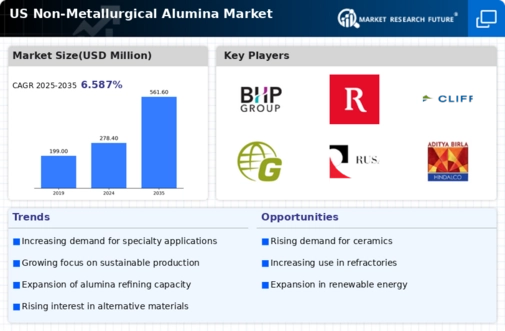The US Non-Metallurgical Alumina Market showcases a dynamic competitive landscape influenced by various factors such as demand for non-metallurgical applications, pricing strategies, and regional regulatory frameworks. This market is characterized by a mix of established players and emerging companies that strive to capture market share through innovative products and services. Competitive insights reveal that companies are increasingly focusing on enhancing production efficiency, sustainability practices, and diversifying their product offerings to meet the evolving needs of end-user industries.
As the sector evolves, understanding the competitive dynamics and strategic positioning of key players is critical for stakeholders aiming to thrive in the US Non-Metallurgical Alumina Market.Alcoa Corporation stands out as a prominent player within the US Non-Metallurgical Alumina Market, leveraging its extensive experience and established reputation in the industry. The company has successfully developed a robust portfolio of alumina refining capabilities, which enables it to efficiently produce high-quality non-metallurgical alumina for various applications, including cement, ceramics, and more.
Alcoa’s strengths lie in its commitment to innovation, operational excellence, and sustainability initiatives that align with the growing demand for environmentally responsible solutions. Their strategic focus on leveraging advanced technologies in refining processes has allowed them to maintain a competitive edge and solidify their presence in the market.China Hongqiao Group Limited has made notable inroads into the US Non-Metallurgical Alumina Market, exemplifying its aggressive expansion strategy. The company is recognized for its diverse portfolio, which includes key products such as alumina hydrate and other non-metallurgical alumina grades, specifically tailored for industries including petroleum, ceramics, and cement.
China Hongqiao Group has positioned itself competitively by investing in advanced production facilities and streamlining operations, resulting in substantial output capabilities. Their market presence is further bolstered by strategic collaborations and potential mergers and acquisitions aimed at enhancing their operational footprint and accessing the US market more effectively. This approach enables them to tap into the unique needs of the local market while addressing supply chain efficiencies, ultimately strengthening their foothold in the US Non-Metallurgical Alumina Market.

















Leave a Comment